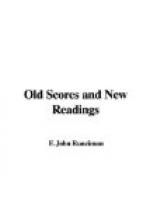his choruses. But in Purcell, despite his sheer
strength, we never fail to get the characteristic
Purcellian touch, the little unexpected inflexion,
or bit of coloured harmony that reminds that this
is the music of the open air, not of the study, that
does more than this, that actually floods you in a
moment with a sense of the spacious blue heavens with
light clouds flying. For instance, one gets it
in the great “Te Deum” in the first section;
again at “To thee, cherubim,” where the
first and second trebles run down in liquid thirds
with magical effect; once more at the fourteenth bar
of “Thou art the King of Glory,” where
he uses the old favourite device of following up the
flattened leading note of the dominant key in one
part by the sharp leading note in another part—a
device used with even more exquisite result in the
chorus of “Full fathom five.” Purcell
is in many ways like Mozart, and in none more than
in these incessantly distinctive touches, though in
character the touches are as the poles apart.
In Mozart, especially when he veils the poignancy
of his emotion under a scholastic mode of expression,
a sudden tremor in the voice, as it were, often betrays
him, and none can resist the pathos of it. Purcell’s
touches are pathetic, too, in another fashion—pathetic
because of the curious sense of human weakness, the
sense of tears, caused by the sudden relaxation of
emotional tension that inevitably results when one
comes on a patch of simple naked beauty when nothing
but elaborate grandeur expressive of powerful exaltation
had been anticipated. That Purcell foresaw this
result, and deliberately used the means to achieve
it, I cannot doubt. Those momentary slackenings
of tense excitement are characteristic of the exalted
mood and inseparable from it, and he must have known
that they really go to augment its intensity.
All Purcell’s choruses, however, are not of
Handelian mould, for he wrote many that are sheer
loveliness from beginning to end, many that are the
very voice of the deepest sadness, many, again, showing
a gaiety, an “unbuttoned” festivity of
feeling, such as never came into music again until
Beethoven introduced it as a new thing. The opening
of one of the complimentary odes, “Celebrate
this festival,” fairly carries one off one’s
feet with the excess of jubilation in the rollicking
rhythm and living melody of it. One of the most
magnificent examples of picturesque music ever written—if
not the most magnificent, at any rate the most delightful
in detail—is the anthem, “Thy way,
O God, is holy.” The picture-painting is
prepared for with astonishing artistic foresight,
and when it begins the effect is tremendous. I
advise everyone who wishes to realise Purcell’s
unheard-of fertility of great and powerful themes
to look at “The clouds poured out water,”
the fugue subject “The voice of Thy thunders,”
the biting emphasis of the passage “the lightnings
shone upon the ground,” and the irresistible
impulse of “The earth was moved.”




